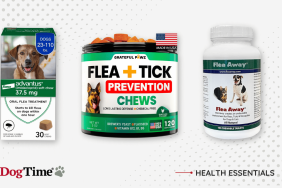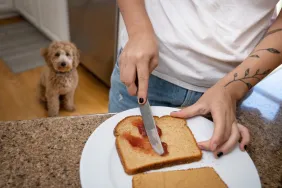Bad breath in dogs, also known by the medical term halitosis, usually results from a buildup of tartar and plaque that develops into periodontal disease.
Certain breeds of canine with flat faces and short noses, known as “brachycephalic” types of dogs, appear to be more susceptible to developing halitosis.
If you see — or, more likely, smell! — signs that your dog might be suffering from halitosis, then you must consult your veterinarian for a proper diagnosis and course of treatment. Here’s what you should know about the symptoms, causes, and treatments of bad breath in dogs.
Symptoms Of Bad Breath In Dogs
You can usually detect bad breath in dogs from the off-putting, stinky odor. Along with the actual breath, the condition can also produce some other symptoms, including:
- Drooling a lot, sometimes with blood in it
- Loss of appetite and developing anorexia
- Pawing around the mouth area as if in pain
- Teeth that seem to be loose
Causes Of Bad Breath In Dogs

Bad breath in dogs most commonly results from periodontal disease, especially a buildup of plaque and tartar; although, there are a number of other issues that might also be at play.
Some of the other common causes include:
- Diabetes
- Sinusitis (inflamed sinuses)
- Gastrointestinal problems
- Rhinitis (inflamed nasal passage)
- Eating garbage
In rarer cases, some sort of trauma has also been linked to causing halitosis in dogs.
In terms of specific dog breeds, brachycephalic dogs generally have a higher predisposition for developing halitosis. Some of the most common of these dog breeds include Boston Terriers, Pugs, and the Pekingese.
Treatments For Bad Breath In Dogs
If you begin to smell that your canine has developed bad breath, your veterinarian will want to carry out a proper examination of their mouth and teeth. Vets can find X-rays very useful in figuring out the root cause of a dog’s periodontal issues.
When it comes to treatment, a thorough cleaning of the teeth is usually the starting point. Your vet can carry out this process, which will also include polishing the teeth.
In instances where damaged or rotting teeth are the cause of the issue, your vet may need to remove individual teeth.
If the problem results from bleeding in the mouth, your vet might suggest medication. As ever, if your vet prescribes your dog any medicine, it’s vital that you stick to the precise dosage and frequency instructions and complete the full course of medication.
In general, it’s best to try and lessen the chances of your dog developing halitosis by keeping up a proper dental care and cleaning routine at home. Your vet can advise you on safe and suitable products to use and suggest a regular cleaning schedule.
In addition, try to avoid letting your dog have access to the garbage can, where they might secretly snack on stinky and rotting foods.
Has your dog ever suffered from bad breath? How do you help keep their breath fresher? Tell us all about it in the comments below.









